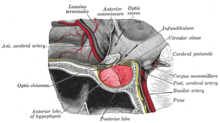Neurohypophysis
The neurohypophysis ( Latin: neurohypophysis ) - sometimes also referred to as the posterior pituitary lobe (HHL) - is part of the pituitary gland ( pituitary gland ). Hormones that are formed in the hypothalamus are axonally transported to the posterior lobe of the neurohypophysis and released into the bloodstream. In contrast to the adenohypophysis , it is part of the brain in terms of developmental history . The term used in human anatomy posterior pituitary refers to the topographical situation in humans, as the posterior pituitary gland forms the rear portion of the pituitary here. In terms of comparative anatomy, however, it is incorrect, since the neurohypophysis in some mammals ( e.g. predators , horses ) is completely enclosed by the adenohypophysis.
Hormones
In the neurohypophysis, two hormones are released into the blood:
- Antidiuretic hormone (ADH; synonyms: adiuretin, vasopressin) regulates water absorption in the kidneys ; the urine becomes more concentrated ( blood pressure rises at the same time )
- Oxytocin causes the smooth muscles , especially the uterus, to contract during childbirth ( Ferguson reflex ) and stimulates the milk to be released in the mammary gland .
anatomy
The neurohypophysis consists of two parts:
- The pituitary stalk (the infundibulum ) connects the pituitary gland to the rest of the brain.
- The posterior lobe (the pars nervosa ) is the posterior part of the pituitary gland.
The neurohypophysis is on the tract hypothalamohypophysialis with the hypothalamus in conjunction. In the supraoptic nucleus formed ADH and in the paraventricular nucleus formed oxytocin to Neurophysins bound by axons transported this tract from the hypothalamus to the pituitary gland and stored there. If necessary, the hormones are proteolytically split by their neurophysin and released into the bloodstream. The neurohypophysis is thus a neurohemal organ .
